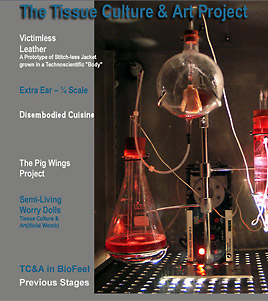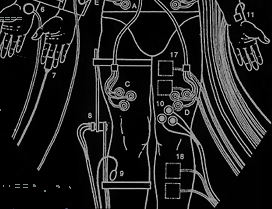Net response: art, tissue, mobility and autonomy
1 Feb 2005
 Net art morphs continually, more or less through periods of stasis and motion. Part of its ethos as an art form is that its many practices shift with techno-cultural change. What's new and used and shared becomes part of the work that is produced. This is the net effect, the history and arguably, differs no more in networked art than in other forms despite the fact that tools, names, processes and knowledge may be couched in the new media rather than in oil paint, celluloid or clay. Some of this morphing culture is in the hands of the artists who use and create it, but much of it is well-beyond our grasp; coming to us, if you will, as the end result of engineers and the digital-industrial cultures where it is produced. Thus, between the product and the culture of an artwork are chains of events which enter into the producing the new species: the new media art work, the net art or the networked culture. We see the latter as a huge shape-shifting, responsive architecture in which net artists play specifically upon the flexing, uncontrollable or unexpected characteristics of that architecture.
Net art morphs continually, more or less through periods of stasis and motion. Part of its ethos as an art form is that its many practices shift with techno-cultural change. What's new and used and shared becomes part of the work that is produced. This is the net effect, the history and arguably, differs no more in networked art than in other forms despite the fact that tools, names, processes and knowledge may be couched in the new media rather than in oil paint, celluloid or clay. Some of this morphing culture is in the hands of the artists who use and create it, but much of it is well-beyond our grasp; coming to us, if you will, as the end result of engineers and the digital-industrial cultures where it is produced. Thus, between the product and the culture of an artwork are chains of events which enter into the producing the new species: the new media art work, the net art or the networked culture. We see the latter as a huge shape-shifting, responsive architecture in which net artists play specifically upon the flexing, uncontrollable or unexpected characteristics of that architecture.
How do we construct and imagine "autonomy" then, in an age of mass amalgamation of ideas, IP, and information?
Currently, we are witnessing the widespread proliferation of open-publishing softwares from 'blogging softwares' to 'wiki' and more. Companies such as Google are providing space for artworks and specialist search functions, expanding through their consumer-base and its commercial and creative needs/critique. Previously thought of as "non-commercial" softwares amidst the techno-utopian net.waves of anarchy and Indymedia, open-publishing has mainstreamed into an "anyone can do it" social-philosophy which has both good and bad attributes. On the one hand, anyone can publish who can make a blog and maintain it. Opinion is rampant and no longer belonging to a few Big Media companies. On the other hand, commercialization of software means necessarily a mainstreaming of 'idea'. The public commons which includes net art cultures does not necessarily benefit from increased capitalization and commercialization of its processes. More conversation is often, also more inconsequential noise, fluff and manipulation on the networks. The current interest in databasing, theorized initially by Lev Manovich as a productive creative form found in avant-garde film, has evolved into cultural critique of search engines and emerging database technologies in terms of their taxonomic biases in the structuring of information and its flows. How do we construct and imagine "autonomy" then, in an age of mass amalgamation of ideas, IP, and information? Clearly, in this phase of the Internet, we need to continue to consider critical differences and what they mean.
New York-based cultural critic, McKenzie Wark writes in his recent book, A Hacker Manifesto that we are living in a time of gross commodification of information. Is the recent resurgence of interest among techno-artists in 'automation' and 'robotics' any indicator that what was at one time thought to be 'human' is now thought to be 'machine'? If corporate gentech has anything to say about it, the answer is 'yes' but what the artists say varies. On the one hand, Australian bioengineering artists Oron Catts, Ionat Zurr and Guy Ben-Ary of the Tissue Culture & Art Project and the Pigs Wings Project in which the already fictionalized object of 'pigs wings' are hand-crafted from pigs ears cells or in which a miniature leather coat is created out of mouse ear cells in 'Victimless Leather', provide a fascinating position on bioengineering art, its place in culture at large, and the sorts of fears and imagination it engenders. Performer Stelarc's prosthetic fantasies and Patricia Piccinini's notorious photographic series of bioengineered critters contextualize this strand of cyberart even further. These works comment on fiction/non-fiction and science fiction while subverting techno-determinist narratives at the heart of bioengineering and declaring, in a sense, a permanent cross-over between science and art through humor and aesthetic beauty in 'tissue' as a medium. Other interpretations might, however, describe this art as responsive to notions of "work" and the vast machinery of techno-scientific culture in which imagination is trapped.
 New technologies support developments in almost every field of human endeavor from agriculture to human reproduction, weapons manufacture and surveillance. Bioengineering art appropriates the techniques of science, much as Da Vinci did, to produce cultural and creative objects of the imagination. In this sense it blurs the distinction between the practical and the prosaic aspects of scientific and medical endeavor. We then could possibly construe bioengineering artwork as an effort to re-inveigh cyber communications with surrealism to cut through the over- systemization of knowledge and culture, to which database researchers and critics are also responding. Absurd or aberrant cyber-imaging which couch whimsical 'pigs wings' (as if they fly!) in real flesh, is a form of shock. Its critique places the hand of God in our ability to construct ordinary folklore or a citizens participation in techno-science and the absurdity that pigs can fly becomes almost real; if flesh is real, that is. This is similar to the issues that the Critical Art Ensemble was working with before being tied up with the FBI. They brought the processes of biotechnology into the everyday by using easily and legally obtained tools for testing GMO foods, a high- concept, low-tech way of saying that the power to choose what we eat is too much in the hands of corporate profit. Our flesh, therefore, is not our own and aren't the networks similarly encumbered?
New technologies support developments in almost every field of human endeavor from agriculture to human reproduction, weapons manufacture and surveillance. Bioengineering art appropriates the techniques of science, much as Da Vinci did, to produce cultural and creative objects of the imagination. In this sense it blurs the distinction between the practical and the prosaic aspects of scientific and medical endeavor. We then could possibly construe bioengineering artwork as an effort to re-inveigh cyber communications with surrealism to cut through the over- systemization of knowledge and culture, to which database researchers and critics are also responding. Absurd or aberrant cyber-imaging which couch whimsical 'pigs wings' (as if they fly!) in real flesh, is a form of shock. Its critique places the hand of God in our ability to construct ordinary folklore or a citizens participation in techno-science and the absurdity that pigs can fly becomes almost real; if flesh is real, that is. This is similar to the issues that the Critical Art Ensemble was working with before being tied up with the FBI. They brought the processes of biotechnology into the everyday by using easily and legally obtained tools for testing GMO foods, a high- concept, low-tech way of saying that the power to choose what we eat is too much in the hands of corporate profit. Our flesh, therefore, is not our own and aren't the networks similarly encumbered?
If flesh, then, is the contested terrain of the 21st century, net arts culture may be in a state of transition from one kind of virtual accuracy, when it comes to humans and machines, to another. The propensity for younger artists in particular to play with notions of automation and generative "anti-art" stances may well be deeply connected to critical works revolving around the role of the body in science, medicine and genetic engineering. We have produced the human genome project and Adam can be downloaded. Where then is techno-feminist thought with respect to the digitization of the body? And how are net artists locating themselves when machines are becoming so tiny as to be invisible; and portable communications are the wave of the future?
Net art itself, once dependent on concepts of 'mobility' in relation to the stationary personal computer and the World Wide Web, now expands into new directions of networked culture to incorporate the miniature, the wireless and the mobile.
Molly HankwitzLecturer
Queensland University of Technology
Creative Industries Research Applications Centre (CIRAC)
m.hankwitz@qut.edu.au
◊